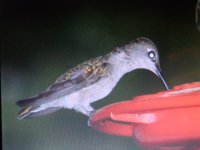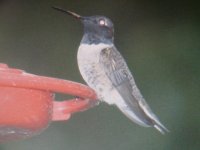I'm glad you posted your analysis, because I hadn't really looked closely at this thread until you did.
It's true that the male's throat iridescence can be of an uncertain color at certain angles, so I won't throw that in against Ruby-throated. I would agree that the tail seems too long and the bill seems too short for Black-chinned - would it be fair to at least agree that these are both Archilochus? Though the wings are a little too "broad and curved" (as Sibley describes it) for my taste, I'll chalk it up to misleading angle/photograph and agree on the male as a Ruby-throated.
The female... I dunno. This could be a Black-chinned, IMO. Tail seems stubby, head seems more gray than green... We can't see the bill for length analysis.





